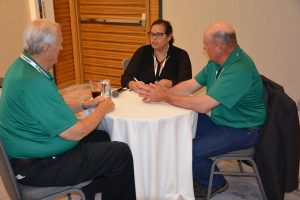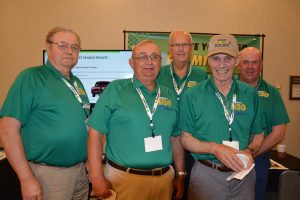
From left to right: Dale Christensen, Glacial Lakes Energy; Joanna Schroeder, Energy.Agwired.com; and Mark Schmidt, Glacial Lakes Energy, discuss the Premium E30 Challenge during the 29th Ethanol Conference.
The ethanol industry knows that one area for the growth of the renewable fuel is through mid-level ethanol blends such as E30. The auto industry is calling for more octane and has indicated that ethanol is one great solution with E30 as the ideal blend. While the two industries seem to be on the same page when it comes to E30, others are not. One way to overcome this barrier, as mentioned by many during the 29th annual ACE Ethanol Conference including fuel experts Dave Hackett, president of Stillwater Associates and Kelly Moore, KMoore Consulting, is that more research on E30 is needed and needed now. Glacial Lakes Energy has heeded the call and several weeks ago launched a Premium E30 challenge in their local community, Watertown, South Dakota. To learn more about the initiative, I spoke with Dave Christensen, Treasurer of the Board, and Mark Schmidt, Board Chairman. I should note that Glacial Lakes Energy was awarded the President’s Award for their ethanol promotional efforts.
The program was borne out of two key issues: the fight against the blend wall, and increasing CAFE standards. By 2025, vehicles must achieve an average of 54.5 miles per gallon (mpg). Schmidt said the auto industry is really close to saying they need ethanol because they need 94 octane, and low and behold, E30 is 94 octane.
Christensen explained that Watertown is an ideal location for the Challenge because they have about 20 blender pumps at six locations selling E30. What they have seen in June and July is an increase in sales of 600 percent. He noted that everyone was worried about check engine lights but so far there have been none.
But more specifically, how does the Premium E30 Challenge work? Schmidt said they have taken several dozen independent vehicles from people in the community who are not associated with the ethanol plant, and first gave them a little check up to ensure the vehicle and its engine was in good condition. Next, Schmidt said they put a data logger on each vehicle then provided each tester with three tanks of E10 and then provided three tanks of E30.
“And that data logger logs every function of that vehicle throughout those six tanks of of fuel,” explained Schmidt. “We haven’t gotten all the data logger data back yet but what we have seen so far is no check engine lights. We might have seen one vehicle with a very, very small loss in miles per gallon, but every car we’ve seen a substantial increase in horsepower and torque. It’s been a great success, and we’ve seen nothing at this point that E30 is going to cause any problems.”
Christensen said they are using all different vehicles and the “tale will come out” when all the data comes in. “But that will be the proof, I think, that ethanol is the fuel of the future.”
Glacial Lakes plans on sharing the final data and encourages all ethanol plants to carry out the same, if not similar, research in their local communities so the data can be shared with the auto industry and the EPA. Both Dale and Mark are also encouraging ethanol plants to contact them directly to learn more about their Premium E30 Challenge and are volunteering to assist any and all ethanol plants who would like to launch similar programs.
To learn more about the E30 Challenge, and selling RIN-less ethanol, listen to my interview with Mark Schmidt and Dale Christensen here: Glacial Lakes E30 Challenge


